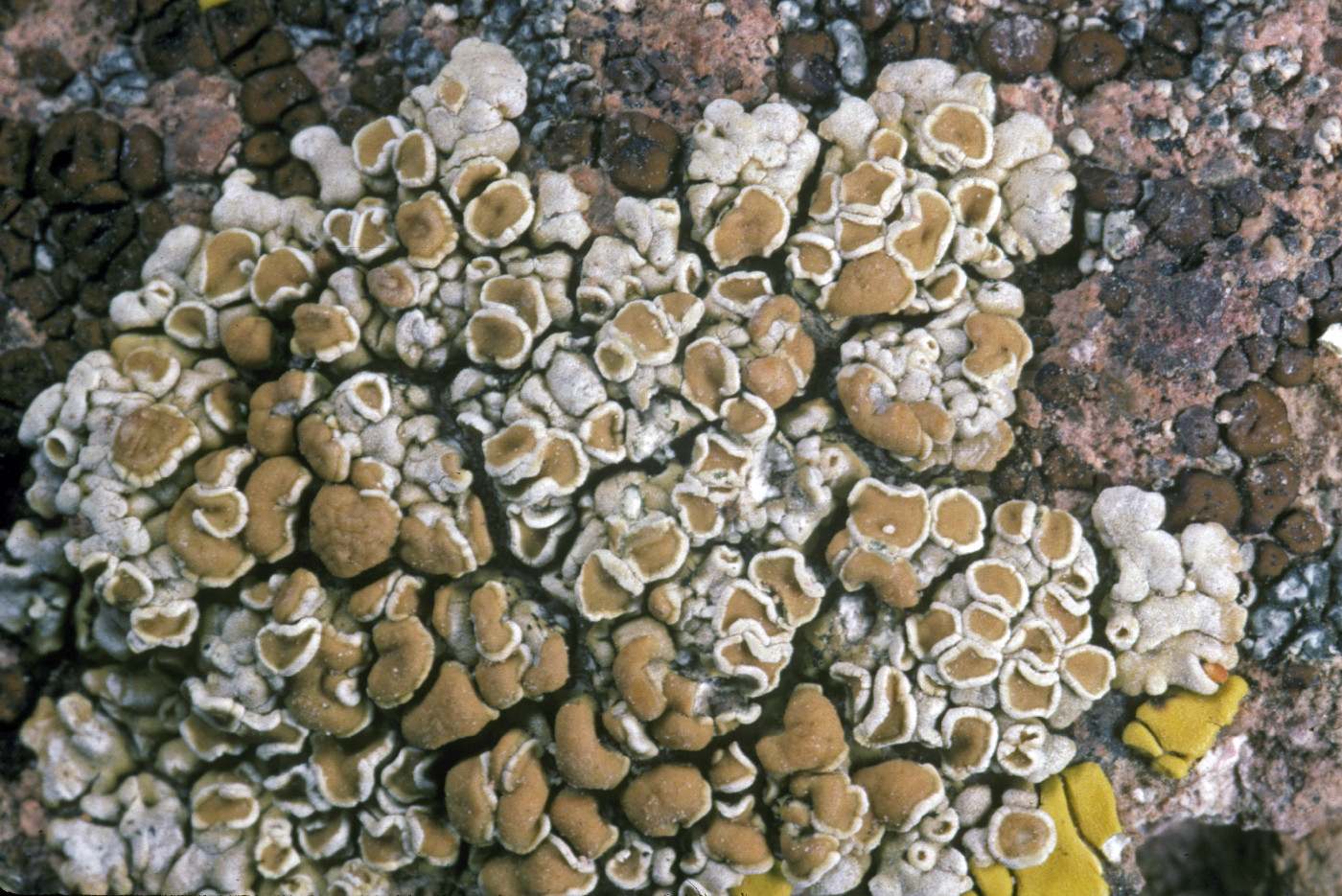
Consortium of Lichen Herbaria
- building a Global Consortium of Bryophytes and Lichens as keystones of cryptobiotic communities -
- Home
- Search
- Images
- Species Checklists
- US States: O-Z >
- US National Parks
- Central America
- South America
- US National Parks
- Southern Subpolar Region
|
|
|
|
Family: Lecanoraceae
[Lecanora kofae B.D. Ryan & T.H. Nash] |
Nash, T.H., Ryan, B.D., Gries, C., Bungartz, F., (eds.) 2004. Lichen Flora of the Greater Sonoran Desert Region. Vol 2. Thallus: placodioid, forming distinct, flattened rosettes, 0.5-1.5 cm wide, 0.5 mm thick in center, tightly attached throughout areoles: +contiguous, irregularly rounded to subangular, 0.5-1 mm wide, plane lobes: radiating, contiguous but discrete (separated by narrow but deep cracks), plane to slightly convex, 2-3 mm long, 0.5-1.5 mm wide, c. 250 µm thick, subentire to coarsely crenate and incised, the ultimate segments c. 0.5 mm wide; sharply transverse cracks sometimes present towards the thallus center; apical areas: often slightly uneven or coarsely and weakly foveolate upper surface: pale greenish yellow, in herbarium becoming yellow, dull, with thin patches of pruina towards the tips of the lobes, esorediate upper cortex: appearing paraplectenchymatous, without dead algal cells, 40-50 µm thick; hyphae: isodiametric to weakly elongated, 3-5 µm across, with lumina c. 2 µm wide, here and there with narrow bundles of elongated, anticlinal hyphae penetrating the algal layer medulla: rather dense; hyphae: c. 5 µm in diam., with narrow, elongated lumina; algal layer: interrupted, c. 50 µm thick lower cortex: not developed except near tips or edges Apothecia: common but not crowded, borne submarginally one per areole, soon sessile, becoming constricted at the base, 1-1.5 mm in diam. disc: slightly orange-yellow or yellow-orange, slightly grayish green next to margin, plane, dull to slightly glossy, epruinose margin: becoming flexuous, somewhat raised (more so when young), 0.1-0.2 mm wide, persistent, with an inconspicuous, pale grayish yellow to tan parathecial ring amphithecium: present, with an interrupted algal layer filling most of the margin, with a distinctly developed medulla only at the base of the apothecia and with variously oriented, elongated hyphae, corticate; cortex: similar in structure to that of the thallus parathecium: indistinct, c. 20 µm thick, similar in structure to the hypothecium but cells more compact, c. 5 µm in diam. epihymenium: yellowish brown, inspersed with fine granules (soluble in K, forming a layer extending above the paraphyses tips) hymenium: hyaline, c. 70 µm tall; paraphyses: rather strongly coherent, with clavate, scarcely enlarged tips; subhymenium: hyaline, indistinct, 25-30 µm thick; hypothecium: with narrow bundles of anticlinal hyphae penetrating the algal layer asci: clavate, 40 x 10 µm, 8-spored ascospores: hyaline, simple, ellipsoid to broadly ellipsoid, 7-11 x 5-6 µm Pycnidia: not seen Spot tests: thallus K-, C-, KC-, P-, UV-; cortex KC+ yellow; medulla KC- Secondary metabolites: upper cortex with usnic acid; medulla with roccellic acid. Substrate and ecology: on vertical to sloping surfaces of smooth siliceous rocks containing or exposed to calcium (HCl+ on the surface, but HCl- inside), in relatively shaded sites or humid microhabitats in the Sonoran Desert World and Sonoran distribution: Arizona (Yuma County), 590-650 m. Notes: Lecanora kofae is superficially somewhat similar to L. neodegelii, but L. kofae has a more flattened and distinctly rosulate thallus with somewhat elongated marginal lobes, and has cortical hyphal bundles dividing the algal layer. |
Powered by Symbiota
















